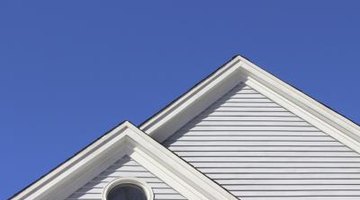What Is a Clapboard House?
Clapboard houses, and clapboards themselves, have a long history. A clapboard a narrow board, thicker on one edge than the other, that serves as house siding. Clapboard houses became common when houses started being built using frame construction and in places where wood was abundant and cheap.
Clapboard Architecture

The word clapboard is derived from the Dutch word "klappen," which means to split. A clapboard house has wooden siding mounted horizontally. Today, many homes with synthetic siding imitates clapboard. On a clapboard house, one clapboard overlaps the one below it, which is why one edge is thicker than the opposite one. Such siding is often referred to as lap siding.
Weather Protection
Clapboard houses were a determined attempt to protect house occupants and interiors from weather conditions. Clapboard provides protection from the elements because of the overlapping nature of its layout on the frame of a house. With each clapboard above lapping over the clapboard below it, rain and snow can't be blown into the frame or into the house itself. Clapboards are sometimes referred to as "weatherboards."
Frame Construction
Clapboard cladding mounts to standard two-by-four exterior framing. Today you'd place moisture barriers between the frame and the clapboard, but traditionally clapboard was nailed directly to the frames and sometimes caulked with mud to seal cracks. Each wall is cladded by starting at the bottom, with the boards' narrow edges up.
Considerations
In America, clapboard houses first appeared in colonial New England. By the middle of the 20th century, other building techniques and materials began to supplant clapboard construction. When aluminum siding became common in the mid-20th century, along with improvements in house framing and building materials, clapboard house building almost ceased. Due to the construction techniques needed to build a clapboard house, hand-building one in the 21st century is an expensive proposition.
References
Resources
Writer Bio
Tony Guerra served more than 20 years in the U.S. Navy. He also spent seven years as an airline operations manager. Guerra is a former realtor, real-estate salesperson, associate broker and real-estate education instructor. He holds a master's degree in management and a bachelor's degree in interdisciplinary studies.
Photo Credits
- suefeldberg/iStock/Getty Images
More Articles



